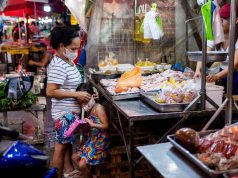MANILA – Inflation rate will likely keep rising until June as the second-round effects of tax reform creep in, an analyst at a global bank said Wednesday, adding that this in turn could trigger three rate hikes from the central bank this year.
Jose Mario I. Cuyegkeng, senior economist at ING Bank N.V. Manila, said inflation will likely average “at least four percent or higher” for 2018, reeling from the impact of Republic Act No. 10963, or the Tax Reform for Acceleration and Inclusion Act (TRAIN), that was enacted in December and which took effect last month.
“I think within the first half of the year, we’ll probably see a peak. Once we get the second-round effects… we expect that to happen within the next three months,” Mr. Cuyegkeng said on the sidelines of ING Bank’s annual financial markets road show Wednesday.
He added that monthly inflation could clock “closer to 4.5%” before easing.
January inflation surprised at four percent, the fastest in over three years to hit the ceiling of the 2-4% target range set by the Bangko Sentral ng Pilipinas (BSP), against a market expectation of 3.5%.
State economic managers attributed January’s price spike partly to effects of the tax reform law, as well as to rising oil and food prices. However, BSP Governor Nestor A. Espenilla, Jr. said TRAIN’s impact is likely temporary and that inflation rate would eventually “stabilize.”
Mr. Cuyegkeng said last month’s faster-than-expected inflation pace bolstered the case for a tightening move from the Monetary Board, as he now prices in three rate hikes for 2018.
He added that there is now a 50% chance for the BSP to adjust rates at its policy meeting today. “Now, there is a case to be made that the central bank has limited choices to stave off any policy rate hikes,” Mr. Cuyegkeng said at the forum, noting that such tightening would help anchor inflation expectations over the next 12-18 months.
“A two-peso increase in minimum transport fares would eventually mean that inflation will still rise by another half percentage point or more,” he added, pointing out that petitions for higher daily minimum wages would likewise have an impact on overall inflation.
The bank economist has also bumped up his inflation forecast from 3.7% previously, which was already above the 3.4% full-year estimate announced by the central bank in December.
By 2019, Mr. Cuyegkeng sees inflation to remain elevated at 3.5-3.6%, coming from another wave of sin tax increases for alcohol and tobacco products.
Despite this, he still expects the Philippine economy to sustain robust growth at 6.7%, matching the pace logged in 2017 on the back of household, public and business spending, as well as growth of industry and services.
The government’s ambitious spending goals for infrastructure may be doable, as he cited “significant improvement” in 2017 budget disbursements.
Despite rising inflation rates, Mr. Cuyegkeng said overheating risks have somehow eased following a moderation in the growth in bank lending and money supply.
ING chief economist Robert Carnell noted in the same event the continued underperformance of the peso against other Asian currencies, which Mr. Cuyegkeng attributed to a widening trade deficit as businesses import more capital equipment and other requirements of expansion.










